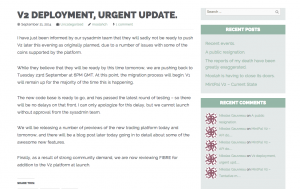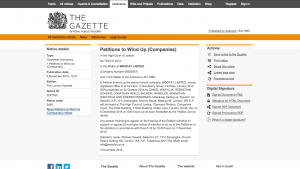INTRODUCTION
A. Review
Trail of Doges v1.0 charted the historical movement of dogecoin from a known Moolah wallet from April 20, 2014 to the time of posting. Trail of Doges 2.0 will adopt the same basic concept by tracing the historical movement of funds associated with a wallet in Moolah’s control. Unlike v1.0, however, v2.0 will work backwards in time from one wallet in Moolah’s current control to another that is believed to have been in his control at a certain point in time.
B. New Information: Summary of Objective and Outcome
The goals of Trail Doges v2.0 will be similar to v1.0: build a baseline information by establishing a starting point on the BTC blockchain and documenting all the transactions between it and the ending point. This post will also build on the method presented last time.
Trail of Doges v1.0 established that the 10M dogecoin given to the prize pool of the e-Sports competition came from a customer wallet affiliated with Moolah’s Prelude Exchange.
Version 2.0 will show that 99.83% of the bitcoin donated to the Remember Carlos mental health fundraiser came from a wallet believed to be a customer wallet on the MintPal Exchange (41.77BTC out of 41.84 BTC donated).
METHOD
A. Review
Trail of Doges v1.0 laid out the following method for tracing digital currency transactions of a particular person:
A. Identifying the Trail
1. Identify a wallet; pick a starting point on the block chain.
Identify an M wallet that is identified as an M wallet by AG. Identification must be from a document, post, media or other source widely understood as being drafted, produced or otherwise operated by AG.
2. Identify as the “starting point” (SP) the earliest point at which said wallet was identified by AG as an M wallet (starting point).
- Identify debits subsequent to SP.
- Capture all recipient wallet addresses and the dates on which said transactions occurred.
3. Identify inputs to the M wallet or converging/merging of multiple wallets with the M wallet.
4. Determine whether there is a remaining/current balance.
B. Analytic foundations
1. Note as a significant wallet (SW) any payee wallets appearing more than once as recipients in a transaction.
- Summarize total amount paid to each SW.
2. Mark as a notable wallet (NW) any payee wallets that correspond with or match notable events and individuals in the Dogecoin and digital currency communities.
- Summarize total amount paid to each NW.
C. Possible Limitations
1. Lack of identifying information beyond public keys.
2. Use of change addresses.
3. Overly simplistic. Blockchain analysis, computer programming/coding, and the like may be beyond my skill set. This post should be seen as very basic and as quite possibly having errors.
4. Confirmation bias.
In short, the method develops a history for the digital currency holdings of a particular person or entity.
B. Supplemental Concepts and Assumptions
Trail of Doges v1.0 employed a linear chronological analysis. Version 2.0 will employ an reverse chronological analysis.
1. Two technologies for analyzing historical data on the blockchain
- Linear Historical Reasoning (best explanation, based on best facts, follows events chronologically)
- Archeological Method (reverse chronological).
Historical reasoning works forward in time from a starting point. It is chronological. Historians construct a story between events, moving forward in time, and explaining events with what he or she believes to be the best or most relevant piece of evidence.
Archaeologies work backwards in time, peeling back layers of information and describing the layered artifacts without judgment about what causes of the different layers. The focus is how data is cultivated and what that data is rather than evaluating or judging it, ideally allowing for observations that may not otherwise have be made.
2. Version 2.0 Adjustments
Even though the chronology, or lack thereof, in v2.0 will be totally different from v1.0, the v1.0 method will be the same except for these three adjustments:
- The SP will be the present time at the time of posting and not a historical event relative to posting.
- From the SP, rather than tracing the largest outputs from one wallet to another, we will trace the largest inputs into a series of transactions (and in reverse chronological order).
- Archaeologists stop digging when they encounter artifacts. We will stop looking backwards in time when we encounter a certain artifact – BTC wallet for the MintPal exchange. Said wallet will be the ending point (EP). The EP, therefore, will be the sole Notable Wallet (NW) in this post.
3. Assumptions
For this post I will assume that the largest input into a transaction represents the change wallet from a spend transaction. In order to build a transaction history, we will, in reverse chronological order, trace the running balance of a wallet believed to be under the control of AG and/or M from one change wallet to the preceding change wallet.
DATA
A. Data Points
1. Wallet – For this post, our SP will be the BTC donation wallet for the Mental Health awareness campaigned started by AG.
The wallet was and is believed to be under M and AG’s control. You will recall that this campaign started in the wake of the alleged suicide of Carlos Rueleas (Carlishio2), who was known for drawing the Dogecoinball cartoons.
AG confirmed that he created the wallet here.
This wallet is interesting for two reasons:
- There is a second layer of authentication. Looking at the transaction history of the BTC wallet for the campaign, I noticed that there have been only 5 btc donations. AG confirmed making this personal donation to the fund (“I have started by donating $20,000 to the Bitcoin address. I intend to donate more, but will be using that to match other donations to encourage people.”). AG’s confirmation of the donation is a second level authenticating factor.
- The timing. Carlishio’s suicide happened on September 6, 2014. It was not announced until Sept 15, 2014. It was around this time AG started missing MintPal migration deadlines:
Moolah’s blog on Sept 17, 2014

Moolah’s blog on Sept 23, 2014

2. Starting Point. The SP will be the time of posting and this wallet: 15bBYUto5ucp3jGbvRHMTWkft8QbF5bqD3 (Remember Carlos Campaign BTC Wallet).
3. Ending Point: 1NjBaY8fKg85TfCvP1AoQGUSXjifD5Nw2G (believed to be Mintpal’s BTC wallet).
4. Transaction History. Transactions preceding the SP:

- GR = Input;
- GE 1 = Send;
- GE 2 = Change Wallet
Some Analytics
1. Significant Wallets (SW)
17ztgkcaZbs4VFrAswMQGvnNDEtn47rsmu – Received over 1100 BTC, in 11 transactions, between Aug 26 and Sept 15.
1yGe5j4xh7fUHdLBcYtLCUj8Rmor4vJzR – Received 2 payments of 5 BTC, one on Sept 8 and on Sept 13.
2. Notable Wallets (NW)
1NjBaY8fKg85TfCvP1AoQGUSXjifD5Nw2G – the Campaign wallet received a contribution directly form the change wallet of the MintPal Exchange.
OBSERVATIONS
1. There is a direct connetion between 99.83% of the Bitcoin donated to the Carlisho2 Mental Health campaign came from MintPal’s BTC wallet (41.77 BTC of 41.84 BTC donated).
2. AG said the 41.77 BTC donation was a personal donation. There is no way to verify that claim at this time. Therefore, Version 2.0 does not state who owned the 41.77 BTC donated to the Remember Carlos donation wallet.
3. The timing of the Remember Carlos mental health campaign announcement corresponds with when MintPal migration deadlines were being missed. The donated bitcoins were not sent to Mind on Oct 1 as represented on remembercarlos.com.
4. The largest donations of dogecoin and litecoin were comparable in relative size to AG’s bitcoin donation vis-à-vis the total amount donated.





